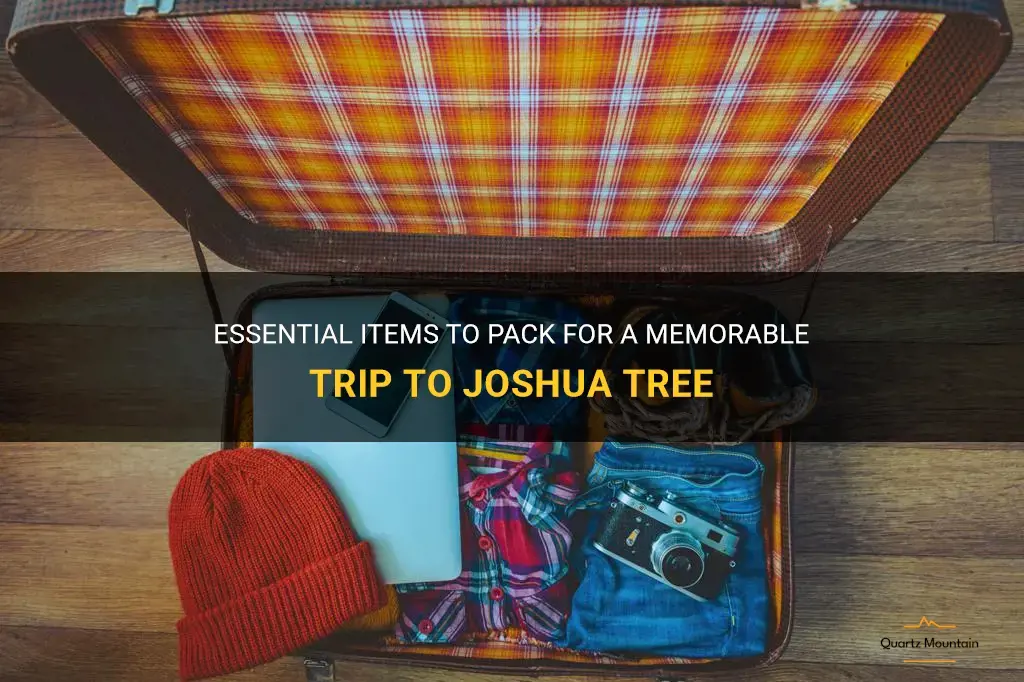
Planning a trip to Joshua Tree National Park? Don't leave home without the essential items that will make your trip not only memorable but also a comfortable and hassle-free experience. From camping gear to hiking essentials, this guide will ensure you have everything you need to fully immerse yourself in the stunning beauty of this desert wonderland. So grab your backpack and get ready to explore Joshua Tree with ease and style!
| Characteristics | Values |
|---|---|
| Temperature | Hot during the day, cool at night |
| Clothing | Light and breathable |
| Sun protection | Hat, sunglasses, sunscreen |
| Water | Carry plenty |
| Footwear | Comfortable hiking shoes |
| Camping gear | Tent, sleeping bag, camping stove |
| Food | Non-perishable and easy to cook |
| Map and compass | For navigation |
| First aid kit | Essential for emergencies |
| Insect repellent | To protect against bugs |
| Camera | For capturing the beautiful scenery |
| Trash bags | Pack out all waste |
What You'll Learn
- What are the essential items to pack for a trip to Joshua Tree?
- Are there any specific clothing items or gear that are recommended for a visit to Joshua Tree?
- What type of footwear is best for exploring Joshua Tree National Park?
- Are there any specific camping equipment or supplies that should be included in a packing list for Joshua Tree?
- Are there any unique items or gear that would enhance the experience of visiting Joshua Tree?

What are the essential items to pack for a trip to Joshua Tree?
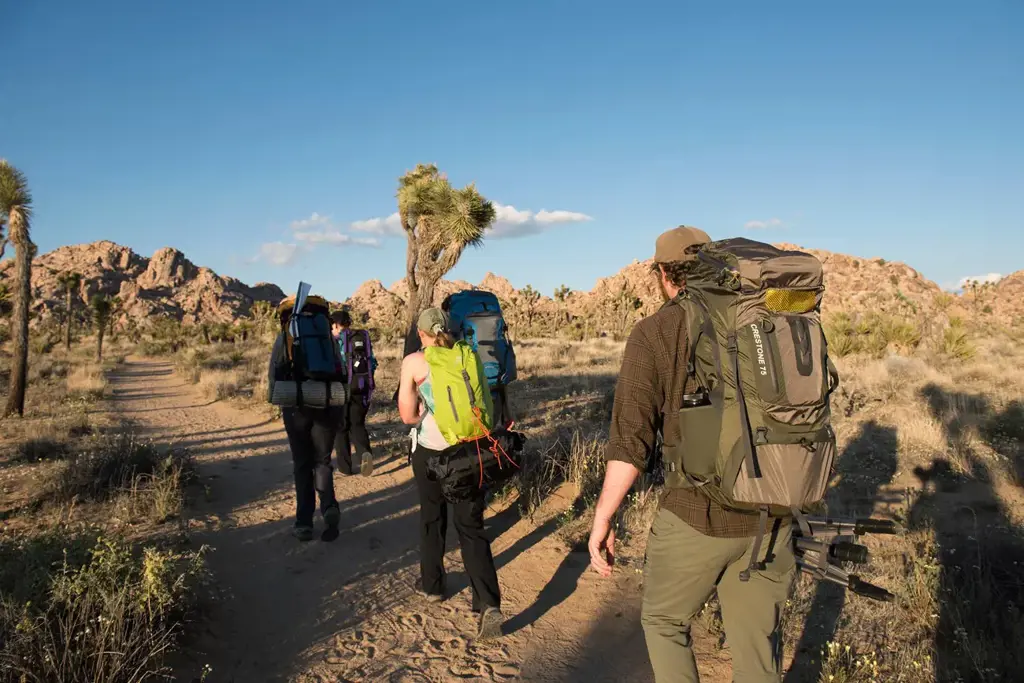
When planning a trip to Joshua Tree National Park, it is important to pack essential items that will enhance your experience and ensure your safety in the desert environment. Whether you are camping or hiking, here are the must-have items to include in your packing list.
- Water: Staying hydrated is crucial in the desert, where temperatures can reach extreme highs. It is recommended to drink at least one gallon of water per person per day. Carry a Camelbak or water bottles to have access to water at all times.
- Sun Protection: The desert sun can be harsh, so pack sunscreen with a high SPF rating and lip balm with SPF. Additionally, bring a wide-brimmed hat, sunglasses, and lightweight, long-sleeved clothing to protect your skin from sunburn.
- Navigation Tools: Joshua Tree National Park covers a vast area with numerous trails and remote areas. Carry a detailed map, a compass, and a GPS device or smartphone with offline maps to navigate the park. Familiarize yourself with the park's topography and trails before setting off.
- First Aid Kit: Accidents can happen anywhere, so it is important to have a well-stocked first aid kit. Include essentials such as bandages, adhesive tape, antiseptic wipes, pain relievers, and any personal medications you may need. Also, make sure to learn basic first aid skills before your trip.
- Sturdy Footwear: The rocky and uneven terrain of Joshua Tree requires proper footwear. Invest in a pair of sturdy hiking boots or trail shoes that offer good ankle support and have a non-slip sole. Break them in before your trip to prevent blisters.
- Layered Clothing: The desert can experience extreme temperature changes, with scorching heat during the day and freezing temperatures at night. Pack lightweight, moisture-wicking clothing suitable for hiking during the day, and layer up with thermal layers, a jacket, and beanie for chilly evenings.
- Camping Gear: If you plan to camp in Joshua Tree, make sure to bring a tent, sleeping bag, sleeping pad, and camping stove if necessary. Check the park's regulations regarding camping and obtain any required permits beforehand. Also, pack enough food and non-perishable snacks to sustain yourself throughout your stay.
- Lighting: The desert gets pitch dark at night, so having a reliable light source is essential. Pack a flashlight or headlamp with extra batteries to navigate your campsite or trails after sunset.
- Wildlife Precautions: Joshua Tree is home to various desert wildlife, including rattlesnakes and scorpions. Bring a snakebite kit and insect repellent, and be mindful of your surroundings to avoid any close encounters. Store your food securely in animal-proof containers.
- Emergency Supplies: In case of an emergency, have a whistle, mirror, or a signaling device to attract attention. Carry a fully charged phone or a satellite communication device for emergencies. Inform someone about your itinerary and expected return time.
Remember, a well-prepared and informed traveler will have a safer and more enjoyable experience at Joshua Tree National Park. By packing these essential items and following proper safety guidelines, you can fully appreciate the beautiful desert landscape and make lasting memories.
Essential Items to Pack for a Memorable Trip to Gatlinburg
You may want to see also

Are there any specific clothing items or gear that are recommended for a visit to Joshua Tree?
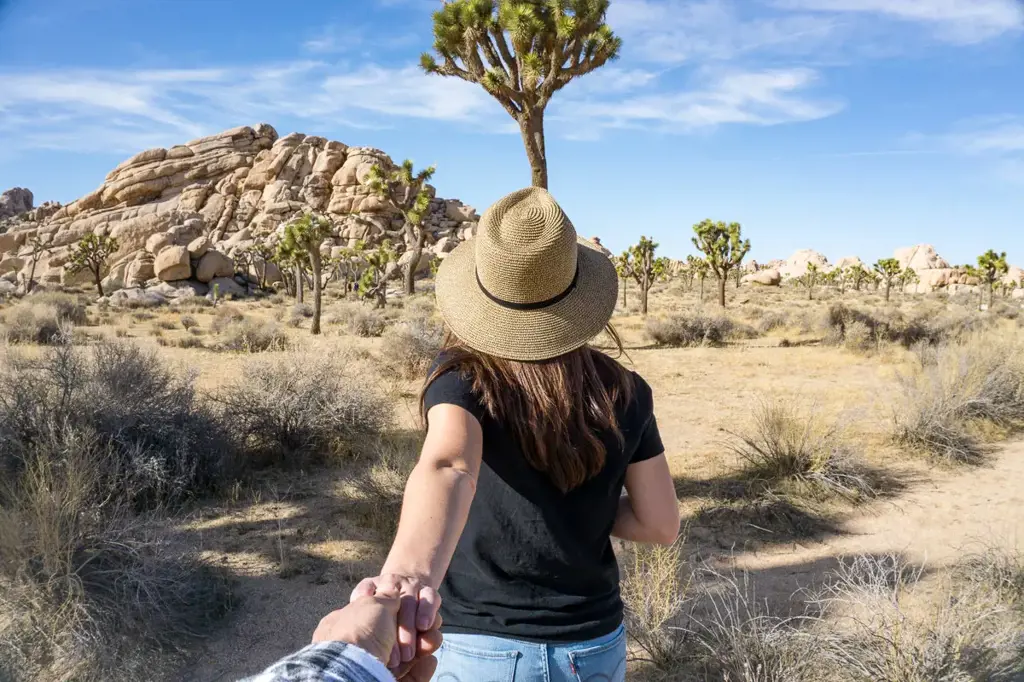
When planning a visit to Joshua Tree, it is important to be prepared with the right clothing and gear to make the most of your experience. The unique desert environment of Joshua Tree National Park presents some challenges, and having the appropriate clothing and gear can help ensure you have a safe and enjoyable trip.
One of the most important items of clothing to bring is comfortable and breathable clothing. Temperatures in Joshua Tree can vary greatly throughout the day, so it's important to dress in layers. In the winter months, temperatures can drop below freezing at night, so a warm jacket or fleece is essential. During the day, however, temperatures can soar, so it's important to have lightweight, moisture-wicking clothing that will keep you cool and dry.
In addition to clothing, it is also crucial to have the right footwear. The terrain in Joshua Tree is rocky and uneven, so it's important to have sturdy, closed-toe shoes or boots with good traction. Hiking boots are highly recommended, as they provide ankle support and protection from rocks and cacti. Avoid open-toe shoes or sandals, as they can be uncomfortable and increase the risk of injury.
Another important piece of gear to bring to Joshua Tree is a hat. The sun can be intense, and a wide-brimmed hat can provide shade and protect your face and neck from sunburn. Additionally, sunglasses with UV protection are essential to protect your eyes from the bright desert sun.
It's also important to bring plenty of sunscreen and apply it regularly throughout the day. The high elevation and clear desert skies make for intense sun exposure, even in the winter months. Look for sunscreen with a high SPF (30 or above) and apply it to all exposed areas of your body, including your face, neck, and hands.
Lastly, don't forget to bring plenty of water. Staying hydrated is crucial in the desert, especially when engaging in physical activities such as hiking or climbing. Bring a refillable water bottle and aim to drink at least one liter of water per hour of activity. It's also a good idea to bring extra water in case of emergencies or unexpected delays.
In summary, when visiting Joshua Tree, it is crucial to come prepared with the right clothing and gear. Dress in layers, wear sturdy footwear, and don't forget a hat and sunglasses for sun protection. Apply sunscreen regularly and bring plenty of water to stay hydrated. By following these recommendations, you can ensure a safe and enjoyable visit to Joshua Tree National Park.
Essential Items to Pack for a November Visit to Phoenix
You may want to see also

What type of footwear is best for exploring Joshua Tree National Park?
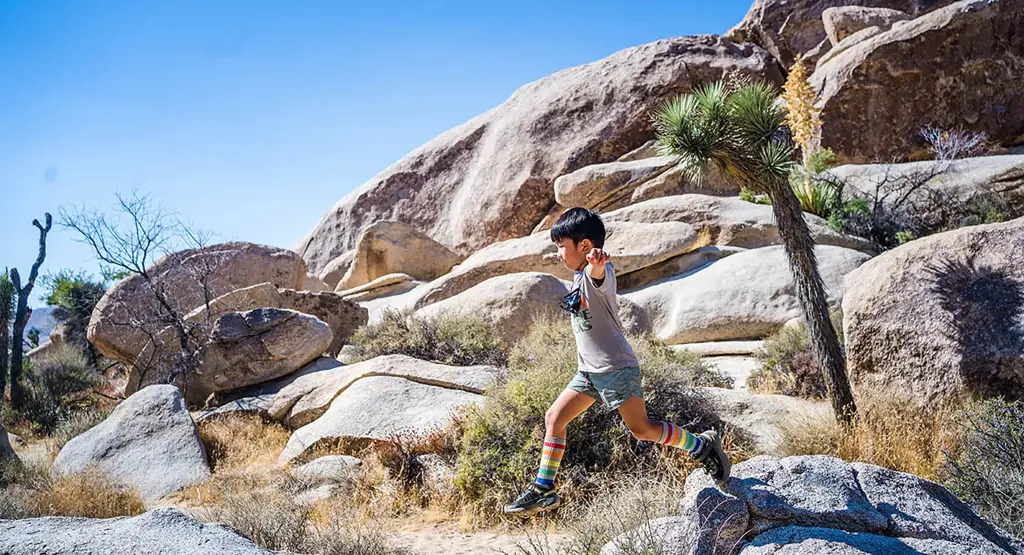
When it comes to exploring Joshua Tree National Park, having the right footwear is essential. With its rugged terrain, varied surfaces, and unique rock formations, this park offers an unforgettable outdoor experience. But with so many options available, it can be challenging to know what type of footwear is best for navigating this diverse landscape. In this article, we will explore the different options and provide you with the necessary information to make an informed decision.
Hiking boots are the most popular choice for exploring Joshua Tree National Park. These boots offer ankle support and stability, which is crucial when hiking over uneven surfaces and navigating rocky trails. Look for boots with good traction to ensure you can confidently grip the terrain. It is also essential to find boots that fit well and are comfortable for long periods of walking. Investing in a high-quality pair of hiking boots can make a significant difference in your overall experience in the park.
For less rigorous hikes or casual exploration, hiking shoes or trail running shoes can be a suitable alternative to boots. These shoes offer similar traction and stability, but they are lighter and more breathable. This is especially important in the hot desert climate of Joshua Tree. However, keep in mind that hiking shoes may not provide as much ankle support as boots, so it's essential to assess your needs and the difficulty level of the trails you plan to tackle.
Another option to consider is approach shoes. These shoes are designed for technical scrambling and climbing, making them ideal if you plan to traverse the park's rock formations. Approach shoes provide a sticky rubber sole for excellent grip on rocks and have a climbing-inspired design with enhanced toe protection. They offer the ideal combination of hiking shoe comfort and climbing shoe performance, making them a popular choice among rock climbers and boulderers exploring Joshua Tree National Park.
In addition to the type of footwear, sock selection is also crucial. Look for socks made of moisture-wicking materials to keep your feet dry and blister-free. Consider wearing wool or synthetic blend socks that are cushioned and offer extra support. Avoid cotton socks, as they can retain moisture and increase the risk of blisters.
It's also essential to break in your footwear before visiting Joshua Tree National Park. New boots or shoes can cause discomfort and blisters if not properly worn in. Take the time to wear your footwear on shorter hikes or walks to allow them to mold to your feet and ensure a comfortable fit during your adventure in the park.
To get a better understanding of the type of footwear that is best for exploring Joshua Tree National Park, let's look at some real-life examples. Gary, an experienced hiker, recommends wearing lightweight hiking shoes for most trails in the park. He finds that these shoes provide sufficient traction, are breathable, and allow him to move swiftly through the terrain. However, he advises bringing hiking boots for more demanding hikes or when exploring the park’s remote areas.
On the other hand, Sarah, a rock climber, suggests wearing approach shoes when focusing on the park's rock formations. Approach shoes give her the confidence to climb and scramble over rocks with ease while maintaining the necessary grip. She often pairs her shoes with moisture-wicking wool socks to ensure comfort and prevent blisters.
In conclusion, the type of footwear you choose for exploring Joshua Tree National Park depends on the level of difficulty of the trails you plan to tackle and your individual needs and preferences. Hiking boots provide excellent ankle support and stability, making them ideal for rigorous hikes. Hiking shoes or trail running shoes are lighter alternatives suitable for less demanding trails or casual exploration. Approach shoes are ideal for technical scrambling and climbing. Whatever footwear you choose, ensure they are comfortable, well-fitted, and suitable for the conditions you will encounter in the park. Happy exploring!
The Essential Items to Pack in Your Disney Backpack
You may want to see also

Are there any specific camping equipment or supplies that should be included in a packing list for Joshua Tree?
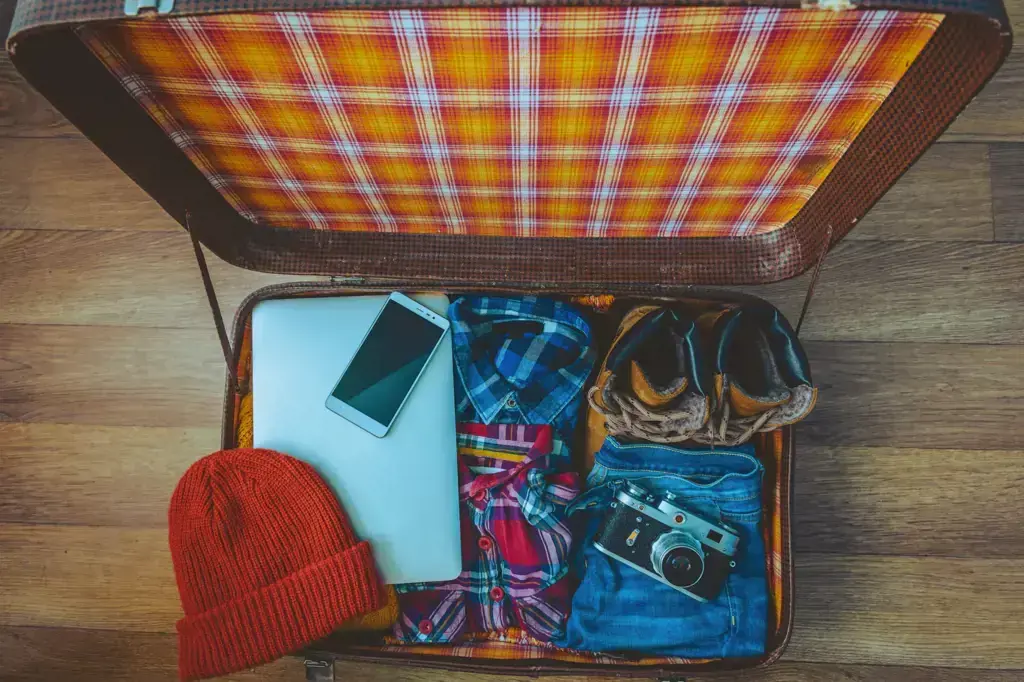
When planning a camping trip to Joshua Tree National Park, it is essential to have the right equipment and supplies to ensure a comfortable and enjoyable experience. Here are some specific camping gear and supplies that should be included in your packing list for Joshua Tree:
- Tent: A sturdy and reliable tent is a must-have when camping in Joshua Tree. Choose a tent that can withstand high winds and has good ventilation to combat the desert heat.
- Sleeping bag and pad: Temperatures can drop significantly at night in Joshua Tree, so it is crucial to have a warm and cozy sleeping bag. Additionally, a sleeping pad provides insulation from the cold ground and adds extra comfort.
- Map and compass: Joshua Tree National Park is vast and has a complex network of trails. Packing a detailed map and a compass will help you navigate the park's diverse terrain and find your way back to camp.
- Water containers and filtration system: Staying hydrated is crucial in the desert, so it is important to carry an ample supply of water. Pack refillable water bottles or hydration bladders and a reliable water filtration system to purify water from natural sources if necessary.
- Cooking equipment: Carry a portable camping stove, cookware, and utensils for preparing meals in the park. Make sure to pack lightweight and easy-to-clean options to minimize the weight and hassle of carrying heavy and bulky items.
- Food storage: Proper food storage is essential to prevent encounters with wildlife in Joshua Tree. Invest in bear-resistant food canisters or hang your food using a bear bag and rope to keep it safe from animals.
- Sun protection: The desert sun can be intense, so be sure to pack sunscreen, sunglasses, and wide-brimmed hats to protect yourself from harmful UV rays. It is also helpful to have a lightweight long-sleeved shirt and pants to cover up during peak sun hours.
- First aid kit: Accidents can happen anywhere, so having a well-stocked first aid kit is essential. Include bandages, adhesive tape, pain relievers, antiseptic ointment, and any necessary personal medications.
- Lighting: Headlamps and flashlights are crucial for navigating the campsite and trails at night. Pack extra batteries to ensure you have enough power throughout your trip.
- Clothing layers: Joshua Tree experiences significant temperature fluctuations between day and night. Pack a variety of clothing layers, including lightweight and breathable options for hot days and warmer layers for chilly evenings.
- Insect repellent: While Joshua Tree is not known for heavy mosquito activity, it is advisable to carry insect repellent to ward off any pesky bugs you may encounter.
- Camping permits: Depending on the type of camping you plan to do, you may need to obtain camping permits in advance. Check the park's website for information on permits and reservations.
By including these camping gear and supplies in your packing list for Joshua Tree, you will be well-prepared to enjoy your time in this beautiful desert landscape. Remember to plan ahead, be mindful of the park's regulations, and leave no trace by packing out all your trash. Happy camping!
A Complete Checklist: Essentials for a Romantic Picnic Date
You may want to see also

Are there any unique items or gear that would enhance the experience of visiting Joshua Tree?
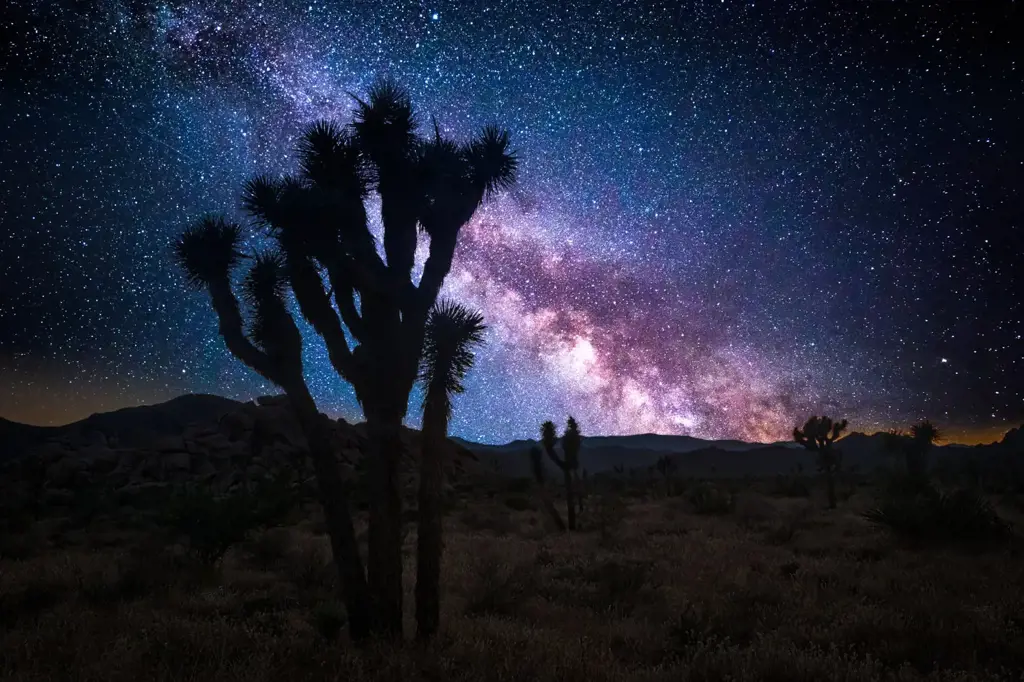
When planning a trip to Joshua Tree National Park, it is important to be adequately prepared with the right gear and items to enhance your experience. The unique landscape and outdoor activities in Joshua Tree require specific items that will ensure your safety and enjoyment.
One essential item that can greatly enhance your experience in Joshua Tree is a good pair of hiking boots. The park's terrain consists of rugged rock formations and desert landscapes, making comfortable and sturdy footwear a must. Hiking boots provide ankle support and protection, allowing you to explore the park's trails and climb the iconic Joshua Tree formations with ease.
Another important item to bring along is a sturdy backpack. A well-designed backpack will allow you to carry all your essential items, such as water, snacks, extra layers of clothing, and a map or guidebook. It is crucial to stay hydrated while exploring Joshua Tree's arid environment, so having a backpack with a water reservoir or plenty of water bottle pockets is highly recommended.
In addition to hiking boots and a backpack, it is essential to have proper sun protection gear. Joshua Tree National Park is located in the Mojave Desert, where the sun can be intense. A wide-brimmed hat, sunglasses, and sunscreen with a high SPF will protect your skin and eyes from the harsh UV rays. It is also advisable to bring a lightweight, breathable long-sleeved shirt and pants to shield yourself from the sun and potential encounters with desert plants.
To fully immerse yourself in the unique experience of Joshua Tree, consider bringing a camping hammock. With its vast open spaces and beautiful night sky, Joshua Tree is an ideal location for stargazing. Setting up a hammock allows you to relax and enjoy the celestial show above you. Additionally, camping hammocks are lightweight and easy to transport, making them a convenient option for overnight stays in the park.
Lastly, a good camera or smartphone with a high-quality camera is a must-have item for capturing the beauty and unique landscape of Joshua Tree. From the iconic Joshua Trees to the striking rock formations and vibrant sunsets, there are countless photo opportunities in the park. Having a reliable camera will allow you to document your adventures and share them with others.
In conclusion, there are several unique items and gear that can greatly enhance your experience of visiting Joshua Tree National Park. Investing in a good pair of hiking boots, a sturdy backpack, sun protection gear, a camping hammock, and a quality camera will ensure your comfort, safety, and ability to fully immerse yourself in the natural beauty of this extraordinary desert park. So pack your bags with these essential items and get ready for an unforgettable adventure in Joshua Tree.
Essential Items to Pack for a 10-Day European Adventure
You may want to see also
Frequently asked questions
It is best to pack comfortable, lightweight clothing that is suitable for the desert climate. This includes t-shirts, shorts, and light pants. It is also important to bring a hat, sunglasses, and sunscreen to protect yourself from the sun.
Hiking boots are not necessary for most trails in Joshua Tree, but sturdy sneakers or hiking shoes with good traction are recommended. The terrain can be rocky and uneven, so it is important to have footwear that will provide support and prevent slipping.
Yes, it is essential to bring a water bottle to Joshua Tree. The desert climate can be hot and dry, and it is important to stay hydrated while exploring the park. It is recommended to carry a reusable water bottle and refill it when needed at the various water stations in the park.
When camping in Joshua Tree, it is important to pack a tent, sleeping bag, and sleeping pad for a comfortable night's sleep. Additionally, you should bring cooking equipment, such as a camp stove and utensils, as well as food and plenty of water. It is also advisable to pack layers of clothing for the cooler desert nights.







